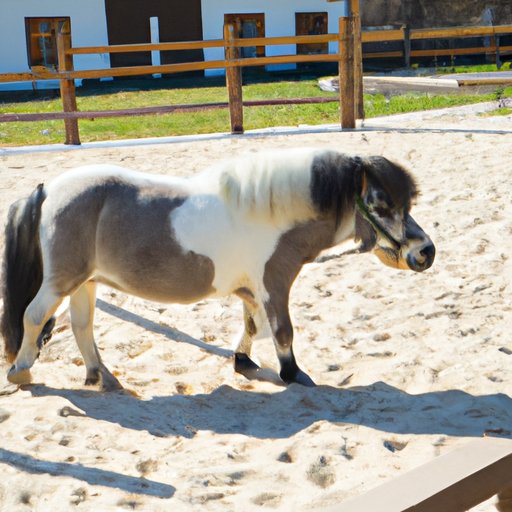Introduction
When it comes to four-legged companions, horses have always been a popular choice, but what about their smaller counterparts, ponies? Ponies are often overlooked, but they are fascinating creatures with unique personalities, history and abilities. In this article, we’ll explore everything you need to know about ponies, from their physical characteristics to their benefits as pets and their role in popular culture and sports. So, whether you’re a beginner or a longtime equestrian, let’s dive into the wonderful world of ponies!
“Pony 101: A Beginner’s Guide”
Before delving into the specifics about ponies, it’s important to know what a pony is and how it differs from a horse. Ponies are horses that measure under 14.2 hands (58 inches) at the highest point of the withers (shoulder blade). This makes them shorter, stockier, and sturdier than their large horse counterparts.
As for physical characteristics, ponies often have broader, rounder barrels and shorter legs than horses. They also have thick manes and tails, larger heads, and are more commonly found in various colors, from solid to spotted.
Ponies can be further classified into three categories: miniature ponies, which are less than 8 hands (32 inches); small ponies, which are 8.1 to 11.2 hands (33-46 inches); and large ponies, which are 11.3 to 14.2 hands (47-58 inches).
“From Shetlands to Welsh Cobs: The Diversity of Ponies”
There are many different breeds of ponies each with their unique physical characteristics and temperament. One of the most popular breeds is the Shetland pony, which originated in the Shetland Islands and was used for hauling peat and plowing fields. This breed is known for its thick coat, strong build, and its playful personality, making it a popular choice as a pet.
Another beloved breed is the Welsh Pony and Cob, which originates from Wales and is known for its versatility, athleticism, and stamina. They were traditionally used for transporting coal and minerals from mines, but because of their athletic abilities, they are also commonly used in equestrian sports.
Other notable breeds include the Connemara, Dartmoor, and New Forest ponies, each with their unique characteristics and qualities.
“Why Ponies Make Great Pets for Children”
Ponies can bring joy and companionship to children, as well as teach them valuable life skills. Owning a pony can teach children about responsibility, empathy, and diligence. Children often bond quickly with ponies, creating an emotional connection that can provide emotional support and comfort. They also promote outdoor activity and exercise, as they require daily care and exercise.
However, owning and handling ponies also comes with risks. Children should always be supervised when handling ponies and should be taught proper safety techniques, such as how to approach a pony safely, the use of safety gear such as helmets, and how to interact with ponies respectfully and correctly.
“The History of Ponies and Their Role in Modern Society”
Ponies have a rich history, dating back to the Ice Age. During the Roman times, ponies were used as pack animals and for riding. In the Middle Ages, they were used heavily in agriculture, transportation, and even warfare.
Today, ponies have a much different role in society. They are commonly used in theme parks, zoos, and fairs, providing rides for children, and they are also used in animal-assisted therapy programs, where they can provide comfort and emotional support to people with a variety of ailments.
“Ponies in Popular Culture: From My Little Pony to Equestrian Sports”
Ponies have become a beloved part of popular culture, particularly in television and movies. Perhaps the most iconic example is My Little Pony, which has been popular since the 1980s and has continued to capture the hearts of young girls for decades. Ponies have also made an impact in equestrian sports, such as polo and show jumping, where they are valued for their speed, agility, and stamina.
Ponies have been used for entertainment and sport for centuries. For example, traveling circuses have often used ponies in their performances, including tricks and jumps. As equestrian sports continue to grow in popularity, so does the role of ponies in these activities, making them an essential and valued part of the equestrian world.
“Breeding and Care of Ponies: Tips for Successful Ownership”
As with any pet, breeding and caring for ponies requires proper knowledge, resources, and care. Proper nutrition is crucial, and ponies require a diet high in fiber, such as hay, pasture grass, and grains. They also require adequate space and exercise, ideally at least a few hours of pasture time a day.
Regular veterinary care is also important, including yearly check-ups and vaccinations. Ponies can be susceptible to various health issues, including obesity, dental issues, and hoof problems, making regular care essential for their overall wellbeing.
If you are interested in breeding ponies, it’s important to thoroughly research and understand breeding basics to ensure the safety of the mare and foal.
Conclusion
Ponies may be smaller than horses, but they are just as fascinating. From their physical characteristics to their history and role in modern society and popular culture, ponies have made their mark on the world.
Whether you’re interested in owning a pony as a pet or pursuing equestrian sports, it’s important to understand the responsibilities that come with owning one. But with the right knowledge and resources, owning a pony can be incredibly rewarding.
